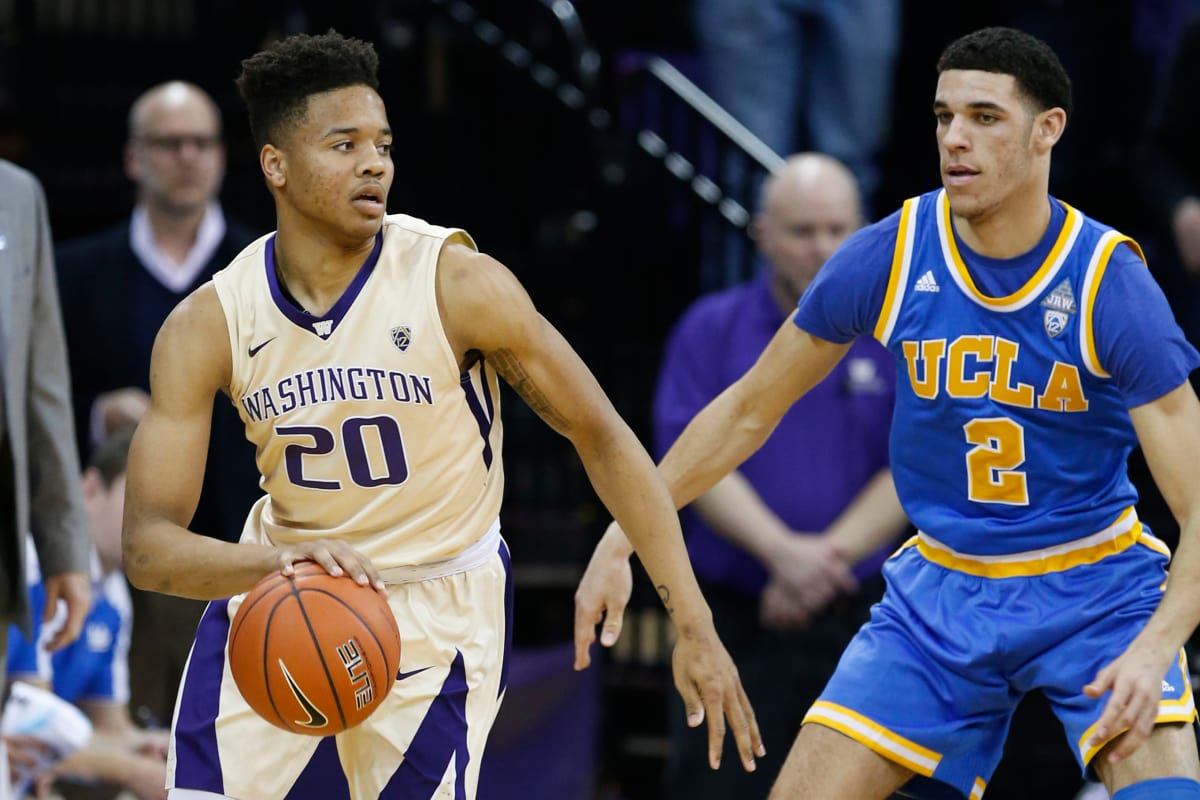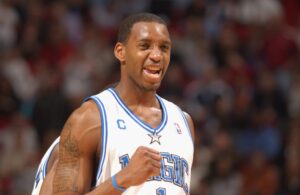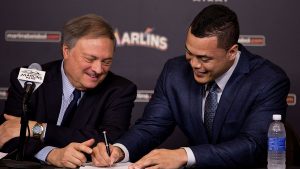- Philadelphia 76ers – Markelle Fultz, PG, Washington (Freshman)
Fultz has been the clear No. 1 pick this entire year, and for good reason. He has no major weaknesses at the point guard spot as a nineteen-year-old, and he can only improve from here. Fultz’s ability to play on or off the ball at 6’5” with a great spot-up jumper makes him a perfect fit next to playmaking forward Ben Simmons. He can shoot, attack the rim, run the pick-and-roll, create for his teammates, break his defender’s ankles, and lock down his matchup on the other end. Concerns about his ability to take over games have been overblown; his supporting cast at Washington was awful, and with real NBA spacing around him in Philly, he should blossom into a star. Philly fans should be excited about the trio of Fultz, Simmons, and Joel Embiid as a big three going forward. Dare I say “The Process” is complete?
- Los Angeles Lakers – Lonzo Ball, PG, UCLA (Freshman)
By far the draft’s most talked-about prospect (oftentimes, for reasons that have little to do with him), the Ball will fit right in with the Lakers’ organizational culture, and playing for your hometown team is always a plus. Ball is one of the most unusual prospects the league has seen in years, a 6’5” point guard with limitless range and the ability to throw passes to anywhere on the court at any time. Ball has compared himself to Lakers president Magic Johnson, a comparison that Magic has said he agrees with. Magic loves Ball so much that he traded young Lakers guard D’Angelo Russell for cents on the dollar on Tuesday to make room for him. There is further trade possibility here with this pick, as the Lakers have been in talks with the Pacers to acquire Paul George, although after the Russell trade, parting with No. 2 would leave the Lakers devoid of a future leader up top.
- Boston Celtics – Jayson Tatum, SF, Duke (Freshman)
In what was a fairly controversial trade last week, the Celtics traded back to third from the No. 1 spot to pick up a future first rounder from the 76ers. Celtics GM Danny Ainge has said the player he chooses third will probably be the same player he would’ve picked first, which made the deal somewhat more encouraging for the Celtics. Tatum seems like the player Ainge has coveted this entire time. Tatum has an array of post and midrange moves to go with the shooting touch to finish all of them. Tatum was so efficient as an iso scorer in college that Duke coach Mike Krzyzewski allowed him to play one-on-one in his normally ball-movement-heavy offense. While a lot of people have Josh Jackson here, it would be an odd pick with last year’s third pick Jaylen Brown seemingly entrenched in his role. Hopefully, the Celtics turn Tatum into their go-to scorer of the future, because they passed on what seems like a sure thing in Fultz to get him. This pick has also been in play for Jimmy Butler at different points this week, a possibility that is getting more and more likely as we approach the draft.
- Phoenix Suns – Josh Jackson, SF, Kansas (Freshman)
The Suns and the Celtics are both getting the better fit for their franchise here, as Jackson should fill their hole at the small forward spot with a hyper-athlete to slot in next to Devin Booker, Eric Bledsoe, and whichever of their 45,368 young bigs pans out. For some bizarre reason, Jackson refused to work out for the Celtics unless they would commit to drafting him beforehand, which it seems would defeat the purpose of a workout. Jackson is one of the best pure athletes at the position to come out of college in the last few drafts, and his defensive potential is just about limitless with his 6’10” wingspan and lightning-quick feet. Jackson’s jump shot needs work, but his ability to create off the dribble as a point forward allows him to cover for some of his shooting deficiencies by setting up his more accurate teammates. Non-shooting defensive forwards have been hit-or-miss in recent drafts, from Kawhi Leonard to Michael Kidd-Gilchrist, and the Suns are certainly in need of a hit here.
- Sacramento Kings – De’Aaron Fox, PG, Kentucky (Freshman)
Fox has, God knows why, expressed a personal wish to play for the Kings, which makes no sense to anyone who has followed basketball for the last decade. Affinity for the Kings aside, Fox is an absolutely electric prospect who compares very well to John Wall coming out of college. Fox is easily the fastest player in the draft, and his speed and quickness have made him both a premiere fast-break player and a lockdown defender at times. There are concerns about his thin frame and lack of a 3-point shot, but his ability to hit mid-range jumpers and free throws looks good for his development. If he hits the weight room and works on his shot, he could be one of the most dynamic guards in the league and the player that pulls Sacramento out of the NBA’s shadow realm.
- Orlando Magic – Jonathan Isaac, SF, Florida State (Freshman)
Isaac has both one of the highest ceilings and lowest floors in this draft class, but the there are questions about how close to his potential he will come. He has the versatility to play either forward spot, and combines a 6’11” frame and 7’2” wingspan with a serviceable 3-point shot and explosive athleticism. His defensive versatility allows him to guard almost every position on the floor, and he is an advanced rebounder for his age. On paper, he seems perfect for the modern NBA, but his lack of a scorer’s mindset and aggression makes him uncharacteristically passive for a player so talented. His inability to handle the basketball probably means he’ll never be a go-to scorer, but he could absolutely be an all-star as the third option on a good team or a top-tier role player as a starter.
- Minnesota Timberwolves – Lauri Markkanen, PF, Arizona (Freshman)
The T-Wolves would love Isaac here as a stretch four, but they’ll take Markkanen as a consolation. Markkanen can pretty much do it all offensively, from shooting on all three levels to attacking off the bounce and finishing above the rim. Markkanen’s biggest issue is his, for lack of a better term, guard-ish-ness. At seven feet tall and only 225 pounds, he can’t score or guard the post, protect the rim, or rebound at an elite level. He’s pretty much a shooting guard stuck in a center’s body. Thankfully, Karl-Anthony Towns can do a few of those things, and Markkanen should find himself a nice role as one of many foundational pieces in Minnesota.
- New York Knicks – Dennis Smith, PG, North Carolina State (Freshman)
Of all the fun offensive-minded point guards in this draft class, Dennis Smith has the most flair as a scorer. With a reported 48” vertical, deep range on his 3-point jumper and the explosiveness off the dribble to get to the rim practically at will, Smith possesses just about everything a modern guard needs to score 20 a game. He’s also a very good, but not great, playmaker, and absorbs contact at the rim with crafty finishes with either hand. However, he tends to be lax defensively and turns the ball over too often as a result of trying to take over games on his own. He’ll be a great fit for the Knicks and the city of New York, and he and (hopefully) Kristaps Porzingis will make a great duo for the future of the franchise.
- Dallas Mavericks – Malik Monk, SG, Kentucky (Freshman)
Very rarely does arguably the best scorer in the draft go ninth. Monk has a full offensive skillset, is one of the class’ best shooters, and can jump out the gym. Monk’s shot-creation ability is elite at times, and he can score from just about anywhere. His 42” vertical means he can get over the top and finish over length above the rim. At 6’4”, Monk is a bit of a tweener, but he has the handles to play the point. His defense is his biggest weakness; with only a 6’3” wingspan and a 197-pound frame, he struggles in man-to-man defense. Dallas would use him as a point, at least initially, hoping he turns into an top-tier scorer on-par with the rest of the explosive guards in the west.
- Sacramento Kings – Zach Collins, PF, Gonzaga (Freshman)
The first true big man comes off the board at No.10, which would be the lowest spot in league history. Collins has the range to hit the NBA three, an array of post moves, and the timing to be a great rebounder and shot blocker. Next to Willie Cauley-Stein, Collins should form a great defensive big man duo, as both can protect the rim and guard the perimeter. Collins has issues defending post-ups, and he’s susceptible to getting bullied in the post because of his thin frame and below-average wingspan. His basketball IQ is also not up to league standards, as he’s one of the worst passers and creators in the draft. Should Collins start allowing the game to come to him and hit the gym, he’ll be one of the steals of this draft.
- Charlotte Hornets – Frank Ntilikina, PG, Strasbourg (Would-be Freshman)
Ntilikina is this draft’s Giannis Antetokounmpo, and it’s not just because his name is hard to spell. The 6’5” point guard with a 7’1” wingspan has had a serious rotation role on one of the better teams in the French league as an 18-year-old. The Belgian-born Ntilikina is one of the best perimeter defenders in the class, using his foot speed and ridiculous wingspan to poke the ball loose from opposing guards. Ntilikina can guard 1-3 effectively without looking out-of-place. His shooting ability will allow him to play off-ball with Kemba Walker, and he can lock up most NBA shooting guards. Ntilikina is a gifted pick-and-roll passer, but his major weakness is his inability to handle the ball under pressure. He dribbles really high off the court and struggles especially attacking the rim despite his length. The key to his development will be how he develops as a shot creator, and if he does, he could be one of the best two-way guards in the league.
- Detroit Pistons – Luke Kenard, SG, Duke (Sophomore)
The first upperclassman off the board, Kenard is the best spot-up shooter in the draft class. He was a ridiculously efficient scorer at Duke and can create shots for himself by attacking off the catch. Kenard’s best NBA asset is his 3-point shooting, which perfectly complements his attentive off-ball movements and reputation as a clutch and contested shot maker. Kenard has the basketball IQ of a point guard and has shown the ability to run the pick-and-roll effectively. Although his offensive skillset is more versatile than most expect, his defense is as one-dimensional as advertised. Kenard is not a great athlete, has a short wingspan, and lacks the frame to stay in front of wings at the NBA level. Despite this, Detroit always seems desperate for extra shooting, and after Kenard’s stellar workouts, it looks like he can give Detroit what they want.
- Denver Nuggets – Donovan Mitchell, SG, Louisville (Sophomore)
Denver is hoping to get its third guard of the future here to pair with the already-impressive Mudiay-Murray backcourt. All three of them are tweeners, which should work well rotationally. Mitchell has serious 3-and-D potential, combining 35% 3-point shooting with 2.6 steals per 40 minutes in college. Despite standing only 6’3”, Mitchell’s 6’10” wingspan allows him to guard three positions without a hitch. He combines his frame with top-flight athleticism, possessing a 40” vertical. However, he is weakest on drives to the hoop. Mitchell’s lack of a left hand, compounded by the fact that he is exclusively a two-foot jumper, makes him susceptible to getting his shot blocked on drives to the rim. He needs to progress more as a playmaker, too, often settling for contested fallaways or lacking the vision to find the open man on drives to the rim. Denver’s never-ending quest to stockpile assets will continue with Mitchell, and should he pan out, he’ll be a perennial 6th man of the year candidate.
- Miami Heat – John Collins, PF, Wake Forest (Sophomore)
Averaging 28.8 points and 14.8 rebounds per 40 minutes while shooting 67%, Collins was easily college basketball’s most efficient player last season. His game is very reminiscent of former third overall pick Jahlil Okafor, with an advanced post-up and midrange game and question marks defensively, although Collins is nowhere near the passer Okafor is. In fact, he’s a far worse distributor than just about anyone in his class, as evinced by his ghastly .28 assist-to-turnover ratio. Collins also lacks IQ on the defensive end of the floor, as he often loses his man around the basket and is commonly caught drastically out of position when the offense attacks the paint. Collins is a great rebounder and pick-and-roll finisher though, which will always have a place on an NBA court. With more experience, Collins could bring his high efficiency to the next level, but if the game proves too fast for him, Miami could be making a mistake here.
Image Credits: USA Today Sports / Jennifer Buchanan





